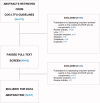A review of the risks of long-term consequences associated with components of the CHOP chemotherapy regimen
- PMID: 35693477
- PMCID: PMC9176678
- DOI: 10.1080/21556660.2022.2073101
A review of the risks of long-term consequences associated with components of the CHOP chemotherapy regimen
Abstract
A common chemotherapy regimen in post-transplant lymphoproliferative disease (PTLD) following solid organ transplants (SOT) is cyclophosphamide, doxorubicin, vincristine, and prednisone (CHOP). This study reviews the quantitative evidence for long-term consequences associated with components of CHOP identified from the Children's Oncology Group Long-Term Follow-Up Guidelines. Cited references were screened using prespecified criteria (English, systematic review, randomized controlled trial n > 100, observation study n > 100, case series n > 20). Relevant data were extracted and synthesized. Of 61 studies, 66% were retrospective cohort studies, 28% were in the US, and 95% enrolled pediatric patients. No study focused specifically on the CHOP regimen. Long-term consequences for CHOP components observed in >3 studies included cardiac toxicity (n = 14), hormone deficiencies/infertility (n = 14), secondary leukemia (n = 7), osteonecrosis (n = 6), and bladder cancer (n = 4). These effects are significant, impact a high percentage of patients, and occur as early as one year after treatment. Although none of the studies focused specifically on the CHOP regimen, 30%, 23%, and 15% evaluated alkylating agents (e.g. cyclophosphamide), anthracyclines (e.g. doxorubicin), and corticosteroids (e.g. prednisone), respectively. All three product classes had a dose-dependent risk of long-term consequences with up to 13.2-fold, 27-fold, 16-fold, 14.5-fold, and 6.2-fold increase in risk of heart failure, early menopause, secondary leukemia, bladder cancer, and osteonecrosis, respectively. Lymphoma patients had significantly elevated risks of cardiac toxicity (up to 12.2-fold), ovarian failure (up to 3.8-fold), and osteonecrosis (up to 6.7-fold). No studies were found in PTLD or SOT. Safe and effective PTLD treatments that potentially avoid these long-term consequences are urgently needed.
Keywords: CHOP; adverse events; long-term outcomes; lymphoproliferative disease; stem cell transplant.
© 2022 Atara Biotherapeutics. Published by Informa UK Limited, trading as Taylor & Francis Group.
Figures
References
-
- Allen UD, Preiksaitis JK, AST Infectious Diseases Community of Practice Epstein-Barr virus and posttransplant lymphoproliferative disorder in solid organ transplantation. Am J Transplant. 2013;(13 Suppl 4):1–120. - PubMed
-
- Parker A, Bowles K, Bradley JA, Haemato-oncology Task Force of the British Committee for Standards in Haematology and British Transplantation Society, et al.. Management of post-transplant lymphoproliferative disorder in adult solid organ transplant recipients – BCSH and BTS guidelines. Br J Haematol. 2010;149(5):693–705. - PubMed
-
- Styczynski J, van der Velden W, Fox CP, Sixth European Conference on Infections in Leukemia, a joint venture of the Infectious Diseases Working Party of the European Society of Blood and Marrow Transplantation (EBMT-IDWP), the Infectious Diseases Group of the European Organization for Research and Treatment of Cancer (EORTC-IDG), the International Immunocompromised Host Society (ICHS) and the European Leukemia Net (ELN), et al.. Management of Epstein-Barr virus infections and post-transplant lymphoproliferative disorders in patients after allogeneic hematopoietic stem cell transplantation: sixth European Conference on infections in leukemia (ECIL-6) guidelines. Haematologica. 2016;101(7):803–811. - PMC - PubMed
-
- Blaes AH, Peterson BA, Bartlett N, et al. . Rituximab therapy is effective for posttransplant lymphoproliferative disorders after solid organ transplantation: results of a phase II trial. Cancer. 2005;104(8):1661–1667. - PubMed
-
- Choquet S, Leblond V, Herbrecht R, et al. . Efficacy and safety of rituximab in B-cell post-transplantation lymphoproliferative disorders: results of a prospective multicenter phase 2 study. Blood. 2006;107(8):3053–3057. - PubMed
LinkOut - more resources
Full Text Sources
Research Materials


